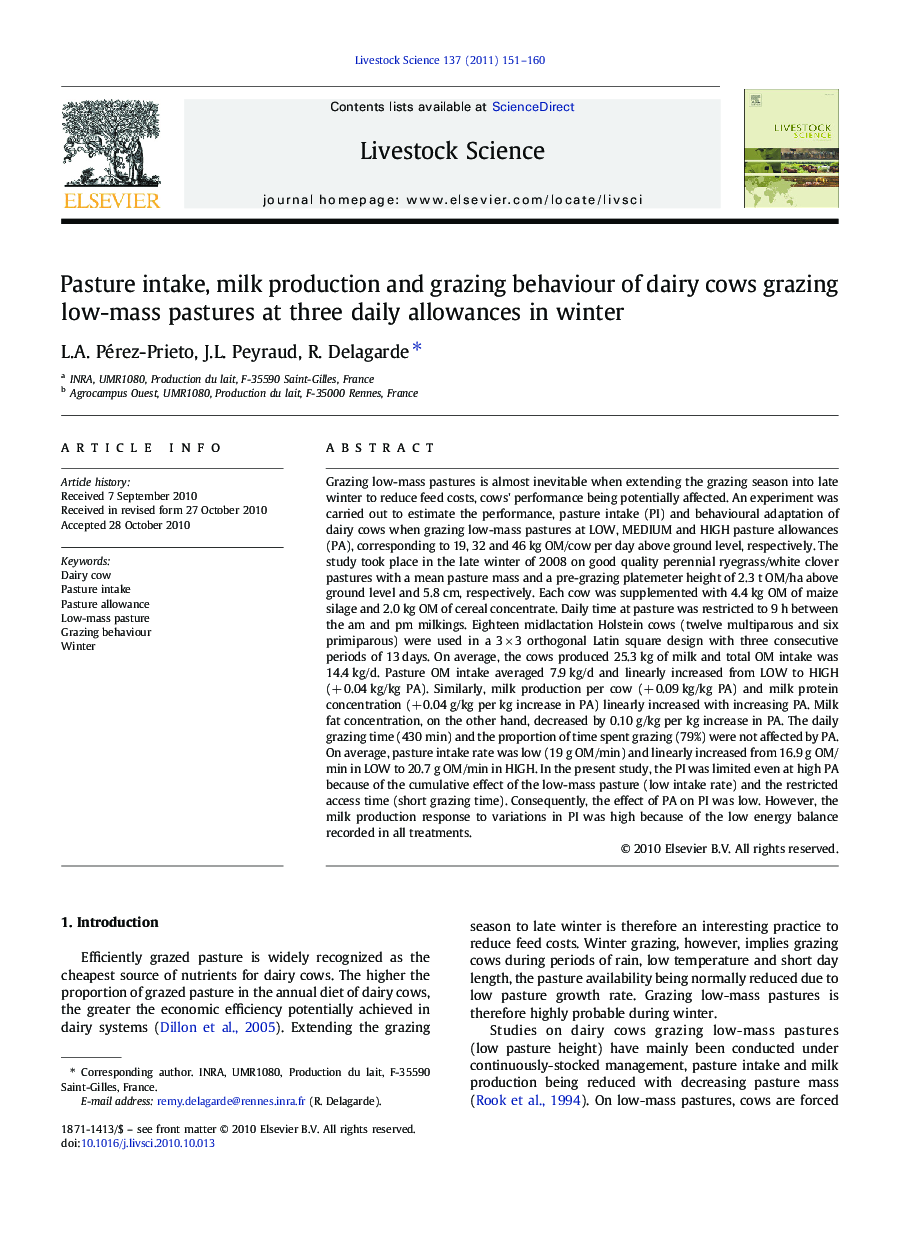| کد مقاله | کد نشریه | سال انتشار | مقاله انگلیسی | نسخه تمام متن |
|---|---|---|---|---|
| 5790970 | 1553995 | 2011 | 10 صفحه PDF | دانلود رایگان |
عنوان انگلیسی مقاله ISI
Pasture intake, milk production and grazing behaviour of dairy cows grazing low-mass pastures at three daily allowances in winter
دانلود مقاله + سفارش ترجمه
دانلود مقاله ISI انگلیسی
رایگان برای ایرانیان
کلمات کلیدی
موضوعات مرتبط
علوم زیستی و بیوفناوری
علوم کشاورزی و بیولوژیک
علوم دامی و جانورشناسی
پیش نمایش صفحه اول مقاله

چکیده انگلیسی
Grazing low-mass pastures is almost inevitable when extending the grazing season into late winter to reduce feed costs, cows' performance being potentially affected. An experiment was carried out to estimate the performance, pasture intake (PI) and behavioural adaptation of dairy cows when grazing low-mass pastures at LOW, MEDIUM and HIGH pasture allowances (PA), corresponding to 19, 32 and 46Â kg OM/cow per day above ground level, respectively. The study took place in the late winter of 2008 on good quality perennial ryegrass/white clover pastures with a mean pasture mass and a pre-grazing platemeter height of 2.3Â t OM/ha above ground level and 5.8Â cm, respectively. Each cow was supplemented with 4.4Â kg OM of maize silage and 2.0Â kg OM of cereal concentrate. Daily time at pasture was restricted to 9Â h between the am and pm milkings. Eighteen midlactation Holstein cows (twelve multiparous and six primiparous) were used in a 3Â ÃÂ 3 orthogonal Latin square design with three consecutive periods of 13Â days. On average, the cows produced 25.3Â kg of milk and total OM intake was 14.4Â kg/d. Pasture OM intake averaged 7.9Â kg/d and linearly increased from LOW to HIGH (+Â 0.04Â kg/kg PA). Similarly, milk production per cow (+Â 0.09Â kg/kg PA) and milk protein concentration (+Â 0.04Â g/kg per kg increase in PA) linearly increased with increasing PA. Milk fat concentration, on the other hand, decreased by 0.10Â g/kg per kg increase in PA. The daily grazing time (430Â min) and the proportion of time spent grazing (79%) were not affected by PA. On average, pasture intake rate was low (19Â g OM/min) and linearly increased from 16.9Â g OM/min in LOW to 20.7Â g OM/min in HIGH. In the present study, the PI was limited even at high PA because of the cumulative effect of the low-mass pasture (low intake rate) and the restricted access time (short grazing time). Consequently, the effect of PA on PI was low. However, the milk production response to variations in PI was high because of the low energy balance recorded in all treatments.
ناشر
Database: Elsevier - ScienceDirect (ساینس دایرکت)
Journal: Livestock Science - Volume 137, Issues 1â3, May 2011, Pages 151-160
Journal: Livestock Science - Volume 137, Issues 1â3, May 2011, Pages 151-160
نویسندگان
L.A. Pérez-Prieto, J.L. Peyraud, R. Delagarde,